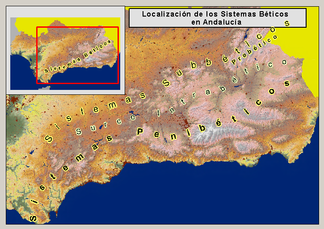Betic Cordillera
| Baetic Cordillera Cordillera Bética |
||
|---|---|---|
|
Betic cordillary system in Andalusia |
||
| Highest peak | Mulhacén ( Sierra Nevada ) ( 3479 msnm ) | |
| location | Spain | |
|
|
||
| Coordinates | 37 ° N , 3 ° W | |
| Type | Fold Mountains | |
| Age of the rock | Alpidic phase (100–50 mya) | |
The Betic Cordillera , Spanish Cordilleras Béticas or Sistema Penibético , also Andalusian Fold Mountains , is a mountain range that extends in the south of Spain from the Bay of Cádiz over 600 km to far beyond Andalusia into the Valencia region .
Landscape and structure
Its center is the Sierra Nevada , with the Mulhacén ( 3482 msnm ) the highest point on the Iberian Peninsula . The westernmost major mountain region that belongs to the Betic Cordillera is the Sierra de Grazalema . To the east of this are the mountains of Ronda with the Sierra de las Nieves , the Sierras Subbéticas , the mountains of Antequera with the most impressive karst features of Andalusia, the Sierra Tejada and the Sierra de Almijara. A number of other mountains follow east of the Sierra Nevada: the Sierra de Baza , the Sierra de Alhamilla, the Sierra de los Filabres with the Calar Alto observatory, the Sierra María , the Sierras de Cazorla, Segura y Las Villas and the Sierra de Castril .
geology
It originated during the Alpidic phase of mountain formation , in which the Pyrenees , Alps , Carpathians , Apennines , Caucasus and Himalayas also emerged. In the southwest the Betic Cordillera continues across the Strait of Gibraltar in the Moroccan Rif , to the northeast the Balearic Islands represent its extension.
The Betic Cordillera consists mainly of material that was formed in the Mesozoic as sediment in the Tethys . The Tethys separated what was then Europe from Africa , just as the Mediterranean does today . Due to its marine origin, the rock is rich in limestone and fossils . There must also have been submarine volcanism , as can be seen from the occurrence of the basic volcanic rock peridotite in some sectors, for example the Sierra de Estepona .
Geologically , the Betic Cordillera is divided into the inner zone in the south , whose rocks come from the Paleozoic and Triassic , and the outer zone to the north , in which there is no Paleozoic rock.
The inner zone consists of three units. Its core is the over 100 km long dome of the Sierra Nevada ( Nevado-Filabriden ), consisting mainly of metamorphic mica schist . It is considered to be autochthonous, so it remained at the place of its origin during the mountain formation. Above this are the other two complexes, two stacks of ceilings that were created outside of the location (allochthonous) and only got here through horizontal transport. Their deeper units ( Alpujarrids ) consist of more or less metamorphic rocks from the Triassic , the Malagids above consist of non-metamorphic Paleozoic rocks.
The outer zone is divided into the Subbetic , which extends from Jaén to the Gulf of Cádiz, and the Prebetic , which extends eastward from Jaén. The rocks of the Sub-Betic were formed in the period Triassic up to and including the Oligocene , but limestone from the Jurassic and Cretaceous are predominant . The rocks of the Prebetic have a more continental history, but limestone also predominates here.
photos
Web links
- La Cordillera Bética y el Parque natural Sierras de Cazorla, Segura y Las Villas ( Memento of January 5, 2010 in the Internet Archive ) (Castilian)





